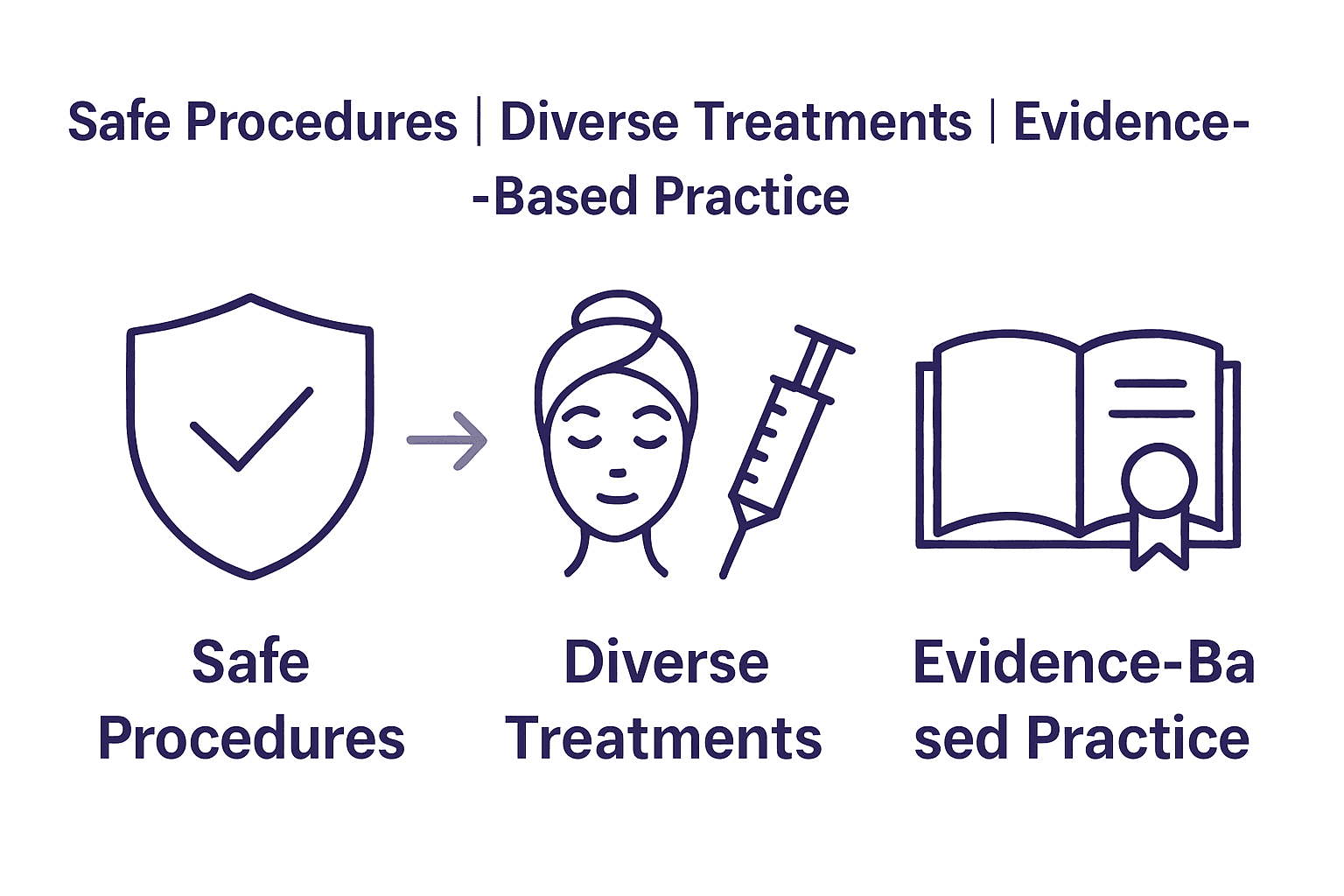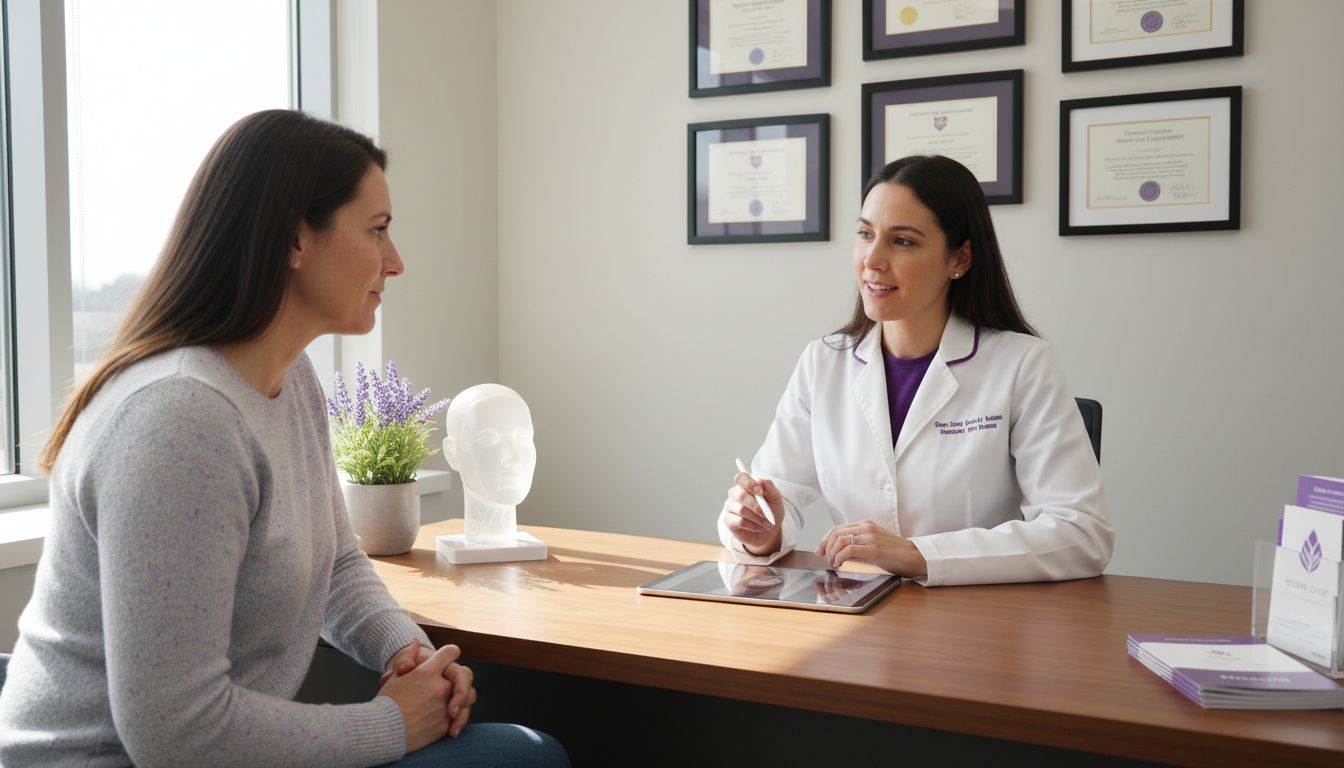Nearly half of those seeking to refresh their appearance now turn to non-surgical treatments rather than surgery. This shift highlights a growing demand for safe, effective ways to enhance natural beauty without lengthy downtime. Medical aesthetics provides access to advanced options designed to support both confidence and personal wellbeing. In this guide, discover how expert-led procedures and strict safety standards can help you achieve lasting, natural-looking results.
Table of Contents
- Defining Medical Aesthetics And Core Principles
- Types Of Medical Aesthetic Treatments Offered
- How Non-Surgical Procedures Work Safely
- Benefits And Why Patients Choose Aesthetics
- Safety, Risks, And Regulatory Standards In Canada
- Common Myths And Selecting The Right Provider
Key Takeaways
| Point | Details |
|---|---|
| Focus on Patient Safety | Medical aesthetics prioritize patient safety and ethical practice, requiring practitioners to adhere to stringent guidelines and undergo specialized training. |
| Diverse Treatment Options | A wide range of non-surgical treatments are available, from medical-grade facials to advanced injectable procedures, addressing various skin concerns. |
| Evidence-Based Practice | Practitioners must meet rigorous regulatory standards and engage in continuous professional development to ensure high-quality care and minimize risks. |
| Myth Busting | Common misconceptions about medical aesthetics can be misleading; thorough consultations and informed decision-making are essential for effective outcomes. |
Defining Medical Aesthetics and Core Principles
Medical aesthetics represents a specialized branch of healthcare focused on non-surgical procedures designed to enhance and restore an individual’s physical appearance. According to BCCNM, these elective clinical interventions are carefully crafted to modify or rejuvenate a person’s aesthetic presentation through targeted treatments.
The core principles of medical aesthetics extend far beyond simple cosmetic enhancement. Patient safety and ethical practice stand at the forefront of this medical discipline. As highlighted by Derma Institute, four fundamental pillars form the foundation of responsible medical aesthetic practice:
- Comprehensive Anatomy Understanding
- Thorough Patient Consultation
- Rigorous Ethical Guidelines
- Stringent Clinical Safety Protocols
These principles ensure that every medical aesthetic procedure is conducted with precision, professionalism, and paramount concern for the patient’s wellbeing. Practitioners must possess specialized training and deep knowledge of human physiology, skin dynamics, and advanced treatment methodologies. Their expertise allows them to recommend personalized solutions that align with each client’s unique aesthetic goals while maintaining the highest standards of medical care.
Medical aesthetic treatments range from minimally invasive procedures like skin rejuvenation and wrinkle reduction to more complex interventions addressing specific dermatological concerns. How to Select Aesthetic Treatments for Your Skin Goals can provide additional insights into navigating these diverse treatment options and understanding which approaches might best suit individual needs.
Types of Medical Aesthetic Treatments Offered
Medical aesthetic treatments represent a diverse array of non-surgical interventions designed to enhance and rejuvenate physical appearance. According to GlowUp Aesthetic Academy, these treatments encompass a wide range of sophisticated procedures targeting various skin concerns and aesthetic goals.
Key Medical Aesthetic Treatments Include:
- Medical-Grade Facials: Deep cleansing and rejuvenation procedures
- Hydrafacial: Advanced hydration and skin resurfacing technique
- Dermaplaning: Precision skin exfoliation method
- Chemical Peels: Targeted skin renewal treatments
- Microneedling: Collagen induction therapy
- Intense Pulsed Light (IPL): Pigmentation and skin texture correction
- Laser Hair Removal: Permanent hair reduction
- Radiofrequency Skin Tightening: Non-invasive skin firmness enhancement
Beyond surface-level treatments, medical aesthetics also includes more advanced injectable procedures. GC Aesthetics highlights specialized interventions such as Botox, dermal fillers, Platelet-Rich Plasma (PRP) injections, Sculptra treatments, and non-surgical rhinoplasty. These precision-based treatments allow practitioners to address specific aesthetic concerns with minimal invasiveness.
7 Essential Types of Skin Treatments for Glowing Results provides comprehensive insights into selecting the most appropriate treatment for individual skin needs. Each procedure is carefully designed to deliver targeted results, helping clients achieve their desired aesthetic outcomes while maintaining natural-looking enhancements.

How Non-Surgical Procedures Work Safely
Non-surgical aesthetic procedures represent a sophisticated intersection of medical expertise and precision technology, designed to enhance appearance with minimal risk and maximum safety. According to Derma Institute, ensuring patient safety requires comprehensive training in critical protocols that protect both practitioners and clients during medical aesthetic interventions.
Key Safety Protocols for Non-Surgical Procedures:
- Hand Hygiene: Strict sanitization standards
- Personal Protective Equipment (PPE): Complete protective gear usage
- Sterilization: Rigorous equipment and workspace cleaning
- Infection Prevention: Comprehensive risk management strategies
- Equipment Maintenance: Regular calibration and quality checks
BCCNM emphasizes that practitioners must meet stringent educational requirements and professional standards before performing medical aesthetic services. These guidelines ensure that only highly trained professionals with specialized knowledge can conduct non-surgical treatments, significantly reducing potential complications and ensuring optimal patient outcomes.
Advanced safety mechanisms in modern non-surgical procedures include precision targeting technologies, real-time skin assessment tools, and individualized treatment protocols. Thread Lifting Explained: Non-Surgical Skin Rejuvenation offers additional insights into how cutting-edge techniques minimize risks while delivering transformative aesthetic results. Each procedure is meticulously designed to provide maximum benefits with minimal invasiveness, prioritizing patient comfort and safety throughout the treatment process.
Benefits and Why Patients Choose Aesthetics
Medical aesthetics has emerged as a powerful approach to personal wellness and self-improvement, offering transformative solutions that go far beyond traditional cosmetic treatments. According to Clinical Beauty Academy, these innovative procedures can significantly enhance natural beauty while simultaneously boosting individual self-confidence.
Key Motivations for Choosing Medical Aesthetic Treatments:
- Non-Invasive Solutions: Minimal recovery time
- Targeted Skin Improvements: Address specific aesthetic concerns
- Natural-Looking Results: Subtle, refined enhancements
- Quick Procedures: Minimal time commitment
- Psychological Benefits: Improved self-image and confidence
Patients are increasingly drawn to medical aesthetic treatments because they offer personalized, scientifically-backed approaches to addressing signs of aging and skin imperfections. These procedures provide a nuanced alternative to traditional surgical interventions, allowing individuals to make incremental improvements that align with their unique aesthetic goals.
Why Consult an Aesthetic Clinic: Complete Guide offers deeper insights into the comprehensive benefits of professional aesthetic consultations. By combining advanced medical technologies with a patient-centered approach, medical aesthetics empowers individuals to feel more confident and comfortable in their own skin, transforming not just physical appearance but overall personal wellness.
Safety, Risks, and Regulatory Standards in Canada
Medical aesthetic procedures in Canada are governed by stringent regulatory frameworks designed to protect patient safety and ensure high-quality professional standards. According to BCCNM, nurse practitioners must undergo specialized additional education and meet comprehensive practice standards before being authorized to provide medical aesthetic services.
Critical Regulatory Safeguards Include:
- Mandatory Professional Certification
- Comprehensive Additional Training Requirements
- Strict Scope of Practice Limitations
- Continuous Professional Development
- Patient Safety Protocol Adherence
Plastic Surgical Nursing Journals emphasize the crucial role of evidence-based education in minimizing risks associated with aesthetic procedures. This approach ensures practitioners are equipped with the latest scientific knowledge and best practices, significantly reducing potential complications and enhancing overall treatment outcomes.
Cosmetic Dermatology: Complete Guide for Canadian Patients provides further insights into navigating the complex landscape of medical aesthetic regulations. By prioritizing rigorous professional standards, Canadian healthcare systems protect patients while maintaining the highest levels of clinical excellence and ethical practice in medical aesthetic treatments.

Common Myths and Selecting the Right Provider
Navigating the world of medical aesthetics requires separating fact from fiction, as numerous myths can mislead potential patients about treatment effectiveness and safety. Derma Institute emphasizes the critical importance of thorough consultations and setting realistic expectations when exploring aesthetic treatments.
Common Medical Aesthetic Myths:
- Myth: Treatments are painful and require extensive recovery
- Myth: Results look unnatural and overdone
- Myth: Only for young or wealthy individuals
- Myth: One treatment solves all aesthetic concerns
- Myth: All providers offer identical quality of care
Selecting the right medical aesthetic provider involves careful consideration of several key factors. Patients should prioritize professionals with verified credentials, extensive training, and a proven track record of successful treatments. Comprehensive consultations that involve detailed skin assessments, transparent discussions about potential outcomes, and personalized treatment plans are essential indicators of a reputable practice.
What Is Cosmetic Consultation? offers additional guidance on preparing for your initial aesthetic assessment. By approaching medical aesthetic treatments with informed skepticism and thorough research, patients can make empowered decisions that align with their unique wellness and aesthetic goals, ensuring safe and satisfying results.
Discover How Medical Aesthetics Can Transform Your Confidence Today
If you are looking to address key concerns like skin aging, texture irregularities, or simply want to rejuvenate your appearance safely and effectively you are not alone. Many people face the challenge of finding personalized, non-surgical solutions that provide natural-looking results without long recovery times. This article highlights the importance of patient safety and ethical practice alongside advanced medical aesthetic treatments like Botox, dermal fillers, and skin rejuvenation procedures. At Simcoe Cosmetic Clinic, we understand these needs and specialize in delivering customized treatments backed by expertise and compassion.

Explore our carefully curated educational resources by visiting Get The Latest Medical Articles – Scclinic.ca to deepen your understanding of aesthetic medicine. Then, take the next step towards radiant, youthful skin by booking a consultation through our landing page. You deserve to experience the benefits of expertly administered procedures designed with your wellness and confidence in mind. Don’t wait to embrace the best version of yourself. Visit Simcoe Cosmetic Clinic today and start your journey to skin health and renewed self-esteem.
Frequently Asked Questions
What is the definition of medical aesthetics?
Medical aesthetics is a specialized branch of healthcare focused on non-surgical procedures that enhance and restore an individual’s physical appearance through targeted treatments.
What are the core principles of medical aesthetics?
The core principles include patient safety, ethical practice, comprehensive anatomy understanding, thorough patient consultation, rigorous ethical guidelines, and stringent clinical safety protocols.
What are some common types of medical aesthetic treatments?
Common types of medical aesthetic treatments include medical-grade facials, Hydrafacial, dermaplaning, chemical peels, microneedling, IPL, laser hair removal, radiofrequency skin tightening, and various injectable procedures like Botox and dermal fillers.
How do non-surgical procedures ensure patient safety?
Patient safety in non-surgical procedures is ensured through comprehensive training, strict adherence to hygiene protocols, the use of personal protective equipment (PPE), sterilization, infection prevention strategies, and regular equipment maintenance.
Recommended
- Cosmetic Dermatology: Complete Guide for Canadian Patients – SIMCOE COSMETIC CLINIC
- Why Consult an Aesthetic Clinic: Complete Guide – SIMCOE COSMETIC CLINIC
- How to Select Aesthetic Treatments for Your Skin Goals – SIMCOE COSMETIC CLINIC
- Find The Best Diabetes Diet and Healthy Food Tips
- Hair and Skin Care: Expert Tips for Stronger Growth 2025 | MyHair



